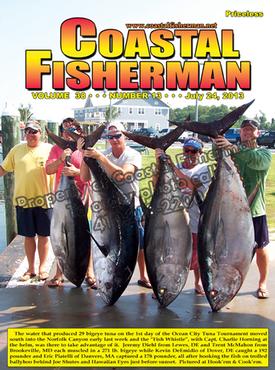


Article by Capt. Mark Sampson
 Whether you’re running through the inlet, fishing along the edge of a channel or just cleaning your boat in its slip at the end of the day, the speed of a passing boat when you’re sitting in yours is probably the one thing that irritates people more than any other aspect of boating. Too close, too fast, too much wake; there are so many things that can get under your skin when another boat comes zooming past. But except for congested areas where there are posted six-mph speed limits, on most bodies of water it’s pretty much up to the operator how fast they want to push their vessel and since no two boats or boat operators are identical in abilities and attitudes, you can bet that on any given body of water, most boats are going to be traveling at wildly different speeds.
Whether you’re running through the inlet, fishing along the edge of a channel or just cleaning your boat in its slip at the end of the day, the speed of a passing boat when you’re sitting in yours is probably the one thing that irritates people more than any other aspect of boating. Too close, too fast, too much wake; there are so many things that can get under your skin when another boat comes zooming past. But except for congested areas where there are posted six-mph speed limits, on most bodies of water it’s pretty much up to the operator how fast they want to push their vessel and since no two boats or boat operators are identical in abilities and attitudes, you can bet that on any given body of water, most boats are going to be traveling at wildly different speeds.
But even though a body of water might have no posted speed limits, “what speed to run” is a decision made by the skipper that must be based on a number of constantly changing variables which will often result in constantly changing speeds of the boat. The mark of a good captain is knowing how to get their vessel from point “A” to point “B” safely, efficiently, and quickly (in that order) and how he uses the throttle to accomplish those goals is just as important as which way he turns the rudder.
Rule “six” in both the International and Inland Rules of the Road states; “Every vessel shall at all times proceed at a safe speed so that she can take proper and effective action to avoid collision and be stopped within a distance appropriate to the prevailing circumstances and conditions.” Notice that this rule says nothing about specific speeds, it just instructs boaters to navigate at whatever speed is best to stay safe. “Safe speed” is, therefore, a judgment call on behalf of the captain. But to properly make that decision one is required to consider such variables as visibility, maneuverability of the vessel, other boat traffic, weather and sea conditions, and anything else that might go wrong if the correct speed is not maintained.
The best example of how speed must be changed to accommodate external conditions is when visibility changes. Imagine a boat that can cruise at 25-knots. By most standards, on a calm ocean, and under clear conditions, that might be a very safe speed. But if that same boat suddenly encounters thick fog that limits visibility to a hundred feet, you can bet that in order to keep from running into someone the skipper might have to throttle way down to maybe 5-knots in order to keep a “safe speed”. If the fog thins and visibility increases to a mile, the safe speed might be increased to maybe 15-knots. Once the fog burns off, the same boat might be back to their 25-knot cruising speed. The same holds true for sea conditions – in order to keep the boat and its passengers safe, the rougher it gets the more the throttle needs to be pulled back or the boat could start coming apart.
Traffic density must always be taken into account when considering how fast to run. Just because you run a certain strip of water every day of your life at a particular speed doesn’t mean that you can continue to do so when you pull up one day and encounter 20 kayakers paddling across the channel. Even in situations where other boaters are doing things that they shouldn’t be doing, like anchoring in the middle of a narrow channel, every boater must maintain a safe speed for both their vessel and surrounding vessels.
Remember, no matter where you are, you are always responsible for the effects of your wake, so don’t cop an attitude like “those guys shouldn’t be there in the first place so they’re just going to have to deal with my wake!” Rule-6 says, “Every vessel shall at all times proceed at a safe speed…”
By the rules, running at a safe speed means that there is no risk of collision. Digging deeper into the rules, one will find that if the operator of a vessel even remotely “thinks” there might be a risk of collision, then he or she is required to take the appropriate action, which in most cases will involve slowing down.
One of the greatest joys of boating is the ability to run “fast and free”, but “fast” can be downright “deadly” or at the very least an annoyance to other boaters when a skipper doesn’t have the smarts to know when to tone it down a bit. So if you don’t want to make enemies, get a ticket, damage a boat or possibly kill someone – slowdown!
Captain Mark Sampson is an outdoor writer and captain of the charter boat “Fish Finder”, docked at the Ocean City Fishing Center.